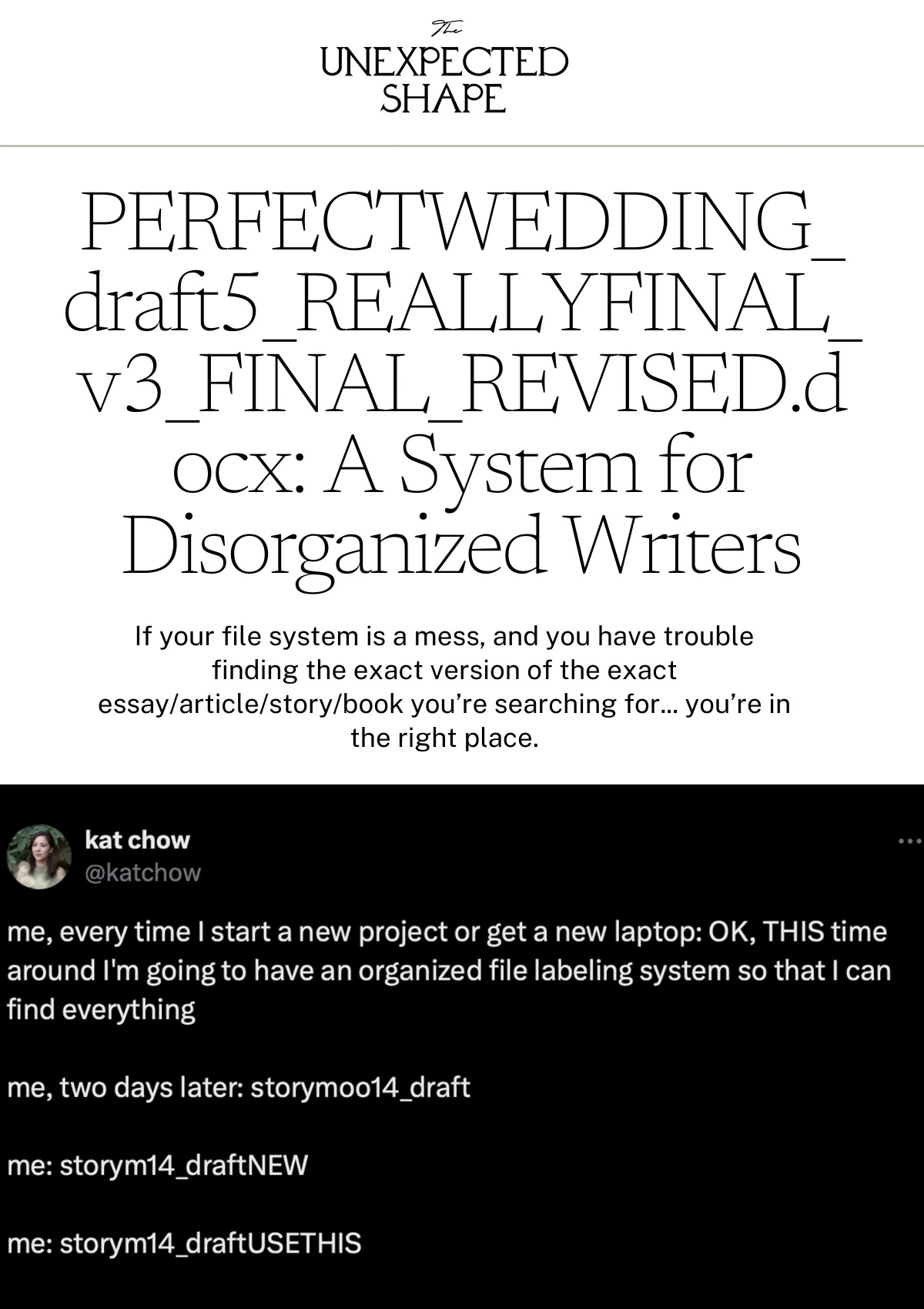PERFECTWEDDING_draft5_REALLYFINAL_v3_FINAL_REVISED.docx: A System for Disorganized Writers
is this you? read on
I’ve come across tweets and memes like this one by Kat Chow—a brilliant writer, by the way, and the author of the memoir Seeing Ghosts*, which you should most definitely pick up—over and over through the years. Here’s a secret that’s not really a secret: writers are good at a lot of things. Having an organized file system… is generally not one of them.
If you’re constantly confused by your own file system, not naturally Type A about your documents, and couldn’t find the fourth draft of the essay you wrote in 2021 about grizzly bears to save your life, I’m here to provide you with a filing system that you can try.
I can’t promise miracles, and maybe it won’t work for you at all (maybe you just love chaos! I won’t stop you, beautiful chaos creature!), but if you’re desperate for a system that keeps your files from disintegrating into absolute entropy, give this system a try.
Here's a detailed step-by-step guide for organizing your writing documents—whether they’re Google Docs, Word documents, or Pages documents—so you can keep track of versions, dates, and names of your essays, articles, stories, and/or whatever else you’ve been jotting down.
Step 1: Create a Writing Folder
On your computer or cloud storage (I use Dropbox), create a master folder named “Writing Projects” or something of that nature. Maybe you want to call it something fun, like My Mushroom Cottage. I can’t stop you.
Example: Writing Projects
Step 2: Set Up Subfolders for Each Category OF WRITING
Inside the your. master folder, create subfolders for each category of writing you do, such as “Essays,” “Articles,” and “Stories.”
Example:
Writing Projects/Essays
Writing Projects/Short Stories
Writing Projects/Articles
Writing Projects/Books
Step 3: Create Project-Specific Folders
For each individual piece of writing, create a folder inside the appropriate category folder. Name this folder using the title of the piece. If you don’t have a title yet, use a phrase that’ll indicate what the piece is about, like “Presidential Debate Reflections.”
Example:
Writing Projects/Substacks/Presidential Debate Reflections
Writing Projects/Short Stories/Cowboys
Step 4: Establish a Naming Convention for Files
Here’s the most important part (in my opinion). Commit to a naming system that remains consistent. I recommend one that has the title, version number, and date. To save you the headache, let’s just say you’ll use [Title][Version][MMDDYYYY].
Example:
Cowboys_v1_08212024.docx
Presidental_Debate_Reflections_v5_08212024.pages
Step 5: Save Early Drafts and Versions
Save a new version of your document every time you make significant changes. Yes, your program probably autosaves, but you might need an older version later for some reason. Update the version number in the file name.
Example:
Cowboys_v3_08242024.docx
Inside each project folder, create subfolders called “In-Progress,” “Drafts,” “Editors,” and “Final Versions.”
Example:
Writing Projects/Short Stories/Cowboys/Editors
Writing Projects/Substacks/Presidential Debate Reflections/Final Versions
So… what do these folders mean?
Keep the most current working version in the dedicated “In-Progress” folder.
Move the early drafts and versions that you’ve been saving (because you are definitely saving them now) into the “Drafts” folder.
“Editors” is for documents that your editor sends you (if your piece is for a publication, or if it’s a book that’s being given feedback by your editor at a publishing house, for example). To stick to the naming convention, RENAME YOUR DOCUMENTS after the editor sends them back to you, because otherwise you’ll end up with whatever your editor likes to call files, and sometimes they’ll call them something like Cowboys-revision-EWW-3.docx, and you’ll be confused all over again. (I mean you no harm, editors. I’m just trying to stay organized.)
Move the final version of your document into the “Final Versions” folder once it’s completed. There should only be ONE FILE in the Final Versions folder, in the end. You can make exceptions if you get back the PDF of, say, the final laid-out version of your book, but otherwise, there should only be actual Final Versions in the Final Version folder. Note that this is usually where people otherwise end up naming things Cowboys_FINALFINALFORSURE_08212024.docx and getting confused.
Now that you’ve got a folder system and some naming conventions, I have a few other tips to help you keep things straight.
Make a folder for notes/research and use descriptive file names inside
If you usually have a bunch of notes or research files for a project, create a Notes and Research folder within the project folder. Your file names should hopefully be as un-chaotic as possible.
Example:
Writing Projects/Substacks/Presidental Debate Reflections/Notes and Research/debatetranscript.pdf
Writing Projects/Substacks/President Debate Reflections/Notes and Research/nytoped-biden.pdf
Back up your work
You ARE backing up your work, right? I think all of us have had some terrible experiences in which our computer crashed before the final version of our senior thesis was saved, or we spilled chocolate milk all over our computer and everything was lost. Maybe your laptop was thieved on a bus, or you left it on a plane and it was never recovered. It’s easier to back up your work now that we have the cloud, but I recommend that you have some other backup method, or if you’re like me, multiple backup methods. I use Backblaze, which backs up my entire computer on a regular basis. And yes, I have had to recover versions from Backblaze from, like, 2013 because my Dropbox underwent a disaster (the story is too depressing for me to recount). Generally, I recommend a cloud system like Dropbox, a secondary backup like Backblaze, and a physical external hard drive with which to back up your important files. Three versions might seem like overdoing it, but LIFE IS A RICH TAPESTRY, and I have complex PTSD. Save your stuff.
I hope this was helpful to you, dear one. If you think this system might assist a hopelessly disorganized writer friend, feel free to forward them this email. Or if you think the writing public should see that there is A Better Way, share it on Notes or some other form of social media. I’ve made this a free post; consider upgrading to a paid subscription, and you’ll get all of my posts, plus access to a Freebies page of resources and a monthly Fireside Chat where I teach things like Self-Care for Creatives. My disabilities prevent me from having a “regular” job; this kind of work is how I make a life. Thanks, all. ❤️
*This is an affiliate link, which means that I will get something like ten cents if you purchase the book from my link.
I made something that I’m proud of. I want to share it with you.
You care about your writing—both practicing the craft & learning how to get better at it.
With a dream of publishing terrific personal nonfiction in your own Substack, in magazines, and/or in the form of bestselling books, you've diligently taken classes from well-known writers through well-respected literary organizations.
But... the way you've been going about it feels confusing.
What if I told you that the problem is none of it fits together?
When you take a lot of different classes from a lot of different sources, you're not getting a comprehensive view of the writing process. Instead of starting first with a holistic view and then leaving to take one-off classes with writers you admire, what you're doing is grabbing classes here and there… which leaves you more confused and lost than you were before.
There is another way: The Unexpected Shape Writing Academy, a new kind of writing school.
⭐ TESTIMONIALS FROM FORMER STUDENTS ⭐
“[The piece that I ended up publishing in the The New Yorker] was about my experience with heart arrhythmias, and I don't think I'd have had the guts (or coping mechanisms) necessary for writing it without The Unexpected Shape.
Being a member of that community and hearing from speakers like Carmen Maria Machado and Suleika Jaouad taught me so much about sharing the painful, challenging moments of my own life—as did the courses you taught, Esmé, and your own book. I'm hoping to use this essay as the launch pad for a book on chronic illness, similar to The Collected Schizophrenias.
Again, thank you so much for creating a space to talk about our limitations, learn to live with them, and write alongside them. It's really hard being in a disabled/chronically ill body, but having other people who understand makes all the difference.”— LORRAINE BOISSONEAULT
“Thanks to the skills I gained in the Academy, I now have my first book coming out!
The Academy was a game-changer. I gained so much insight into the craft of writing—the index card and research classes have been essential—that I have now applied to three different manuscripts ... I have also been published in several dream outlets and refined my practice into something that works with instead of against my limitations."
— CHRISTY TENDING
Cuddling with Daphne when I’m dissociated and need grounding. Chai concentrate that I can use to make chai lattes throughout the workday. Side A of the first record of Reputation by Taylor Swift. Jen Carrington and Sara Tasker - Me & Orla’s gentle podcast for business owners, Letters from a Hopeful Creative. Soaking and freezing blankets, then lying on them because I’m overheated and uncomfortable. Friends who support you. Friends who tell you that you’re being too hard on yourself because you’re being too hard on yourself. Every single person currently in The Unexpected Shape Writing Academy, because they have trusted me with their writing lives and they’re enthusiastic and doing amazing things. The last days of hammock season. Writers who make a difference. You who are reading this. Yes, you.











I read this and then blacked out a little 😂. I wish I could do this. I will try, but it’s very hard for me somehow? I just save everything to Dropbox and hope for the best 😬
Love this! Your system is really similar to mine.